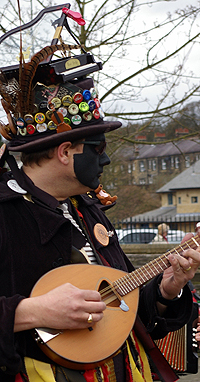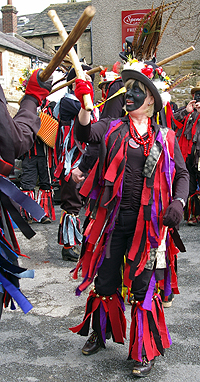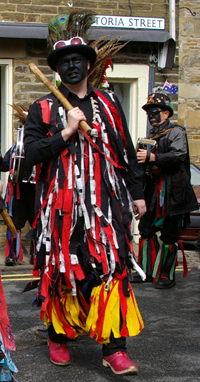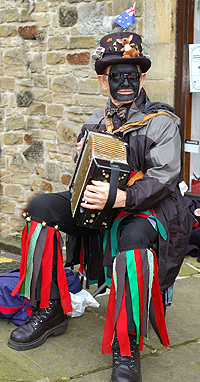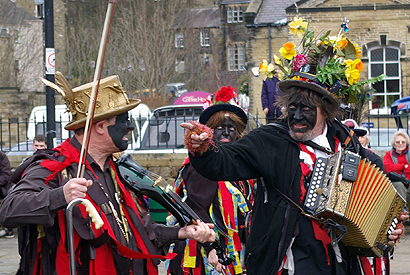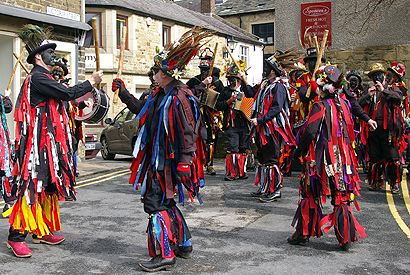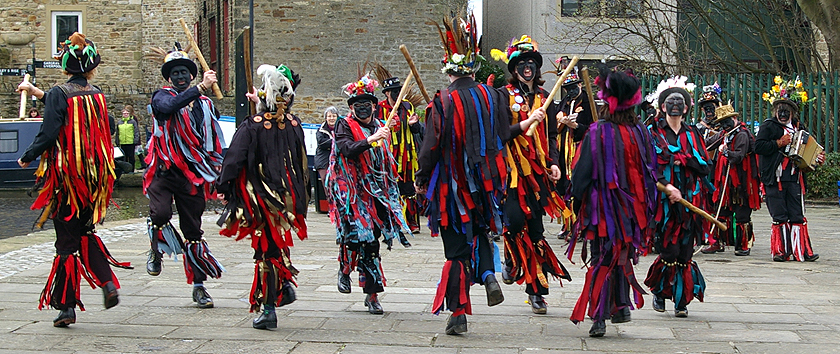The Flagcrackers of Craven.
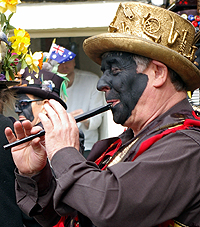
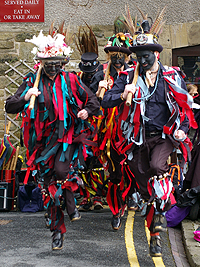 What
a wonderful name to describe this group of enthusiasts who practice their Morris
dancing in the Craven area of Britain. It is well known as one of the most
beautiful areas in Northern England. Its outstanding landscape is reflected in
the designation of two thirds of the District within the Yorkshire Dales
National Park. The District is the most westerly in North Yorkshire, spread
across 450 square miles of land that extends north from a boundary near Skipton,
with West Yorkshire to the southeast, Lancashire to the west, and Cumbria to the
northwest.
What
a wonderful name to describe this group of enthusiasts who practice their Morris
dancing in the Craven area of Britain. It is well known as one of the most
beautiful areas in Northern England. Its outstanding landscape is reflected in
the designation of two thirds of the District within the Yorkshire Dales
National Park. The District is the most westerly in North Yorkshire, spread
across 450 square miles of land that extends north from a boundary near Skipton,
with West Yorkshire to the southeast, Lancashire to the west, and Cumbria to the
northwest.
Its was Easter Monday when I saw them gathering together in Victoria Square in Skipton. There were members of all ages and both sexes and they were preparing to give excellent free entertainment to the visitors. To say they added colour & a uniqueness to this very attractive town, would be an understatement!
Every hat was individually styled, all of them wore black clothes & covered them with coloured strips of cloth & most wore their dancing clogs. But in today's world of political correctness ... they all blacked up! My first thought was the greeting of "Hello Dave" would be wearing thin by now. As the most evil of all the visitors to Royston Vasey, in the cult TV series The League of Gentlemen, Papa Lazarou, was a circus ringmaster with a blackface, who calls everybody "Dave" and steals wives!
These Morris Dancers are a Border side, which means they follow the traditions
of the English & Welsh borders, as against the white dressed Cotswold set who
are known for lots of white hankie waving! The usual explanation for the black face is
that it is for "disguise", and that during the hard winters of the 17-18th
Century out of work labourers and builders sought to anonymously supplement
their income by a bit of dancing and begging. The use of the black face as a
form of disguise is certainly well established in early 18th century England -
so much so, that in 1723 it became a capital offence under the Waltham "Black
Act" to appear "in disguise, either by mask or by blackened face".
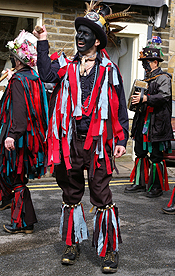 Maybe
the black face tradition, in Lancashire, could owe more to
Maybe
the black face tradition, in Lancashire, could owe more to
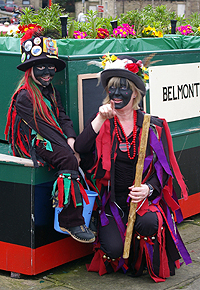 its
being danced by local coal-miners than to any reference to medieval Moorish
styles, that is often quoted. It was also
explained that as part of the disguise, turning their coats inside out showed
their torn & ripped linings. This part of the tradition is now shown in full measure
with their costumes covered in multicoloured cloth strips from head to toe. This
is a hectic style of Morris, with plenty of shouting and stick-clashing.
its
being danced by local coal-miners than to any reference to medieval Moorish
styles, that is often quoted. It was also
explained that as part of the disguise, turning their coats inside out showed
their torn & ripped linings. This part of the tradition is now shown in full measure
with their costumes covered in multicoloured cloth strips from head to toe. This
is a hectic style of Morris, with plenty of shouting and stick-clashing.
On a site about Icons, I liked the statement "As well as national costume, national dishes and a national sport, a nation should have a dance. Argentina has its tango, Poland the polka and England has the Morris. Like much else in our culture, it isnít of unmixed English origin, but derived from Moorish styles of dance back in the 15th century. It filtered throughout western Europe, but it was in England, especially at the Tudor court, that it really took hold".
I was so busy photographing them, I failed to count the instruments they played. I think I can see the big drum, a mandolin, a fiddle, three melodeons, couple of penny whistles & many tambourines. One of the melodeon players helped with the difference between an accordion & a melodeon. "This means that the little beasts play a different note when you suck instead of blow" explained George "they are easy to play simple tunes and fearsomely difficult to play complicated tunes with the right chords, but a great favourite with Morris musicians as they are small and loud, and are easy to phrase for dance rhythms. Melodeons are essentially a couple of large mouth organs with bellows and chord buttons".
I just loved the music & the joy they all showed. Their last dance of the day was called "Bedlam boys" & unusually, it was sung by one of the lady members. It was so different than anything I had ever heard before from any Morris group. A wonderful way to close the entertainment.
Talking to one of the group, it is blindingly obvious that they are there just for the fun ... if they were Irish, they'd be there for the craic but these folk are English. Eccentric, joyous, enthusiastic, skilled and they give it all for free. It was lovely to see one of the children pass amongst the crowd with a bucket, to help with expenses, I'm sure.
